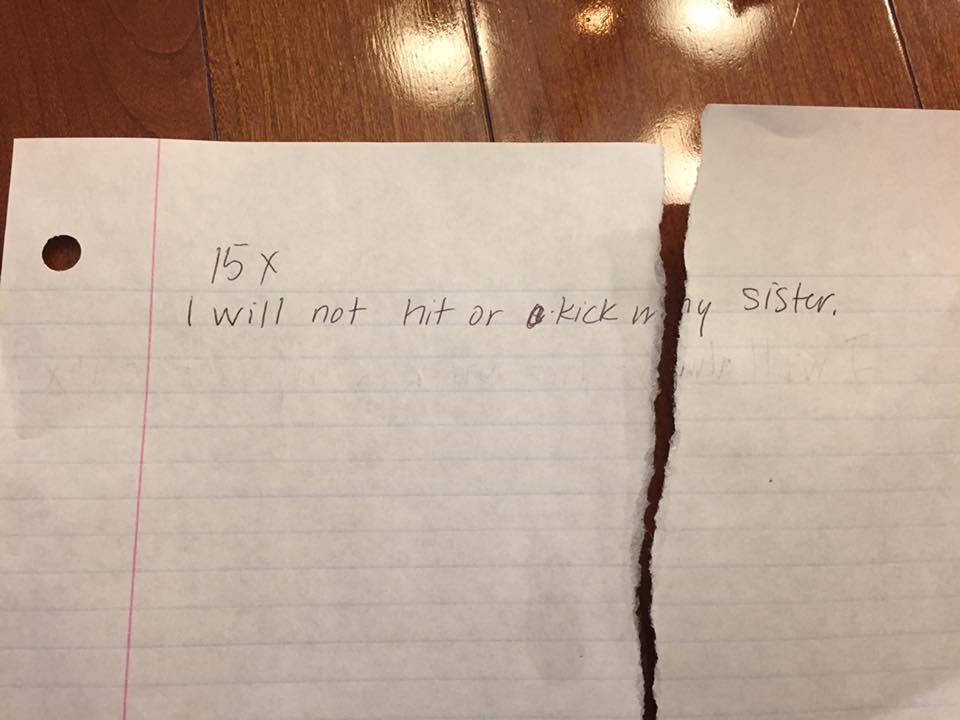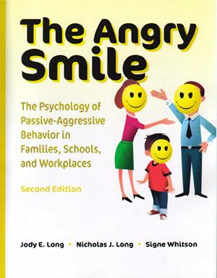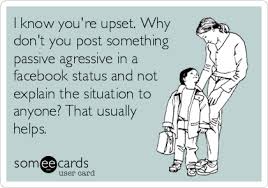Posts tagged The Angry Smile
6 Tips for Confronting Passive Aggressive Behavior
0Do you know someone who is overtly cooperative but covertly defiant? Do you live or work with a person who chronically procrastinates, carries out tasks with intentional inefficiency, or acts as if he or she is the victim of your impossibly high standards? If you know this feeling of being on an emotional roller coaster, chances are good that you are dealing with a passive-aggressive person.
Passive aggression is a deliberate and masked way of expressing covert feelings of anger (Long, Long & Whitson, 2016). It involves a variety of behaviors designed to get back at another person without the other recognizing the underlying anger. In the long run, passive-aggressive behavior can be even more destructive to relationships than aggression. Over time, relationships with a person who is passive-aggressive will become confusing, discouraging, and dysfunctional.
Below, I share a real-life passive-aggressive encounter between a husband and wife, and explain how they could confront and change this destructive pattern of interaction using the process of “benign confrontation.”
For many, confrontation is a scary prospect: Whether out of fear of receiving a person’s anger or out of discomfort with exposing someone’s emotions, some people spend a lifetime hiding from face-to-face, direct communication about others’ behavior. Passive-aggressive individuals know this. They bank on it. In fact, they often select their adversaries based on who will be least likely to attempt to unmask the anger that they so desperately want to keep hidden.
The bad news for those who shy away from confrontation is that without directly addressing passive-aggressive behavior, the pattern will play out against them again and again. The good news is that benign confrontation is nothing to be afraid of. It is not an in-your-face, anger-inspiring, make-them-admit-what-they-did kind of authoritarian tactic. Rather, it is a quiet and reflective verbal intervention skill in which an adult gently but openly shares his or her thoughts about a person’s behavior and unexpressed anger. It is based on the decision not to silently accept a person’s manipulative and controlling behavior any longer.
See how the six-step process of benign confrontation plays out in this husband-wife dynamic:
Richard liked to relax at night when he got home from work. He loved his family, but when it came to the evening hours, he wanted time to himself. And for the month of January, he had had it this way. In helping their 2-year-old daughter, Hayley, adjust to a “big-girl bed,” his wife, Kelly, had taken full responsibility for the bedtime routine. By February, Hayley was able to settle down within 15 minutes and stay in her bed to fall asleep. One night, Kelly asked Richard if he could put Hayley to bed. Richard agreed with the request and went upstairs with Hayley.
From downstairs, Kelly could hear squeals of laughter. She thought to herself, “How nice that they are getting some playtime together.” After 20 minutes passed by, she heard the loud slam of a closet door, and wondered if Hayley needed a new diaper or change of pajamas. When 30 minutes had gone by and loud music started to play from Hayley’s room, Kelly could feel her anger rising. Forty-five minutes after she asked Richard and Hayley to go upstairs for bedtime, Kelly went up to the room and opened the door. Hayley was out of her fleece pajamas and in a bathing suit, sun hat, Barbie sunglasses, and a pair of brand new, too-big, hot pink water shoes.
article continues after advertisement
Hayley ran to her mother with a huge, wide-awake smile: “Bedtime so fun!”
Kelly glared at Richard and exited the room quickly. When he returned downstairs another 35 minutes later and faced Kelly’s angry barrage of questions about what he was thinking and why he would defy the soothing bedtime routine she had worked so hard to create, Richard feigned innocence: “What? We were just having some fun!”
The situation was clear; Richard didn’t want to bother with bedtime routines. Rather than tell Kelly this, and risk an argument over sharing childcare responsibilities, he chose a passive-aggressive response to the situation. The cunning of his personal choice was unmistakable: If Kelly had argued with his stated intention of having fun with his daughter, she would surely have appeared an uptight, no-fun mother—and an overly controlling wife. Richard’s strategy netted a significant short-term win for both his daughter and him: Hayley thoroughly enjoyed bedtime that night and thought her Daddy was the coolest in the world—and Richard would not be called upon to help with this evening responsibility for months to come. Winning a battle, however, sometimes results in losing the war. The long-term impact of chronic passive-aggressive behavior on Richard’s marriage was already beginning to take its toll.
Not wanting to continue harboring feelings of chronic irritation toward her husband, but also unwilling to carry all of the childcare responsibilities on her own, Kelly can use benign confrontation to communicate with Richard about the incident.
1. Know it when you see it.
Once Kelly is aware of typical patterns of passive-aggressive behavior, she can recognize that her husband is expressing unspoken reluctance to give up his evening free time through the intentional undoing of an established bedtime routine. Rather than responding with anger or having a bedtime tantrum worthy of their two-year old, recognizing Richard’s behavior for what it is will help Kelly keep her cool.
2. Decline the Invitation to argue.
While Kelly waits downstairs for Richard to put Hayley to bed, she should manage her rising anger through self-talk strategies: “Richard didn’t want to put Hayley to bed tonight. Rather than telling me in words, he is showing me through this passive-aggressive behavior. I will not allow myself to get caught up in a no-win argument.”
Read the rest of the article on PsychologyToday, or use the link below:
Passive Aggressive Notes from Kids
0I have a love/hate relationship with all of the useless bits of information from my friends’ lives that I can find on Facebook. While I don’t always care so much about the heat intensity of an old college friend’s coffee, the naughtiness of a a neighbor’s pet, or the endless series of alternative facts from our political climate, I do keep trolling on for the occasional gems of daily life…such as this one.
Recently, a friend posted these photos of her attempt at punishing her son for his aggressive behavior toward his sister…and his passive aggressive response to them both (photos posted with permission):
https://www.psychologytoday.com/blog/passive-aggressive-diaries/201703/passive-aggressive-notes
Mom gives 8-year old son a simple writing assignment as a consequence for his aggressive behavior. He is to write “I will not hit or kick my sister” 15 times on a piece of paper:
8-year old son counters in this most passive-aggressive way: “I will always hit and kick my sister 15 times.”
This is a must for inclusion in my next Angry Smile training!
How Passive Aggressive Are You?
0Currently, I am working on updating The Angry Smile text, for what will become the book’s 3rd edition. It’s interesting to think back on how much of my current work and writing on the topics of helping kids manage anger and teaching them to cope with bullying are tied directly to this work with understanding and changing #passiveaggressive behavior. Here’s a light-hearted “test” of how often you use Passive Aggressive Behavior in your daily life:
The Angry Smile at CPI’s Trainer Conference in New Orleans
0This week, I had the honor and pleasure of traveling to one of my favorite cities–New Orleans, LA– to present at the CPI Conference on The Angry Smile and strategies for understanding and changing passive aggressive behavior. This article summarizes some of what I shared with this great group of professionals.
Also, check out the LSCI Institute’s online training based on The Angry Smile, which we proudly partner with CPI to present to professionals and parents everywhere. www.lsci.org
5 Tips for Communicating Assertively without being Passive Aggressive
0Looking for ways to improve your communication at home or at work? This article, written for Psych Central and featuring some of our work from The Angry Smile, offers five strategies for replacing passive aggression with assertiveness:
The Angry Smile Online Training Teaches People How to Manage Passive Aggressive Behavior
0The Angry Smile ONLINE course is NOW AVAILABLE via the Life Space Crisis Intervention Institute’s website! See below for a very special offer…
Is there a person in your life who procrastinates, carries out tasks in intentionally inefficient ways, is quietly manipulative, creates minor but chronic irritation in others, and makes you feel like you are on an emotional roller coaster? If so, you may be working or living with a PASSIVE AGGRESSIVE person.
REGISTER TODAY FOR THE ANGRY SMILE ONLINE TRAINING to discover how to stop frustrating arguments, endless conflict cycles, and relationship-damaging wars of words.
10% DISCOUNT: All participants who register for The Angry Smile Online course during the month of August 2013 will receive a 10% discount on the course fee! Simply enter the code FACEBOOK at checkout and the discount will be applied upon checkout.
When Passive Aggressive Conflict Spirals
0If you have ever become embroiled in a conflict with a passive aggressive person, you know firsthand how abruptly intense your own emotional response can be. The Passive Aggressive Conflict Cycle explains how rational, straightforward, assertive adults can momentarily and unexpectedly depart from their typical personas and take on inappropriate, childlike, and unprofessional behaviors (Long, Long & Whitson, 2008). It describes and predicts the endless, repetitive cycles of conflict that occur when a passive aggressive individual succeeds in getting someone else to act out their anger for them.
In this article I recently posted on Psychology Today, I explain the psychology of the Passive Aggressive Conflict Cycle, so that adults disengage from destructive conflicts and choose relationship-building responses.
http://www.psychologytoday.com/blog/passive-aggressive-diaries/201307/the-passive-aggressive-conflict-cycle
The Angry Smile: Recognizing and Responding to Your Child’s Passive Aggressive Behavior
0Amber had been giving her mother the silent treatment all week. She was angry about not being allowed to sleep over at a friend’s house. Late Thursday night, she left a note on her mother’s pillow, asking her mom to wash her uniform before Friday’s soccer game. When Amber returned home from school on Friday in a rush to pack her gear, she looked all over for her uniform. She finally found it in the washer-perfectly clean, as per her request — but still soaking wet! Amber was late for her game and forced to ride the bench.
When all was un-said and done, Amber’s mother felt defeated. Having one-upped her daughter in the conflict, it was clear to her that she had lost by winning. As parents, most of us have been in situations where traveling the low road is irresistible and we become temporarily reckless in our driving. But anytime we mirror a child’s poor behavior instead of modeling a healthier way to behave, our victories add up to long-term relationship damage and lasting hostilities.
So, what could Amber’s mother have done differently in this hostile un-confrontation? What can any parent do to avoid the agony of victory and the defeat of healthy communication? The following guidelines offer parents strategies for maintaining their calm in a passive-aggressive storm and responding in ways that lay the groundwork for less conflictual relationships with their children and adolescents.
To read more, please click the link below or visit the original post, on the Huffington Post Parents section.
http://www.huffingtonpost.com/signe-whitson/passive-aggressive_b_1417245.html
Passive Aggressive Shopping: Husband vs. Wife
212As we teach in The Angry Smile training, people are willing to go to great lengths to avoid expressing their anger directly…here’s a hilarious one for the passive aggressive files!







